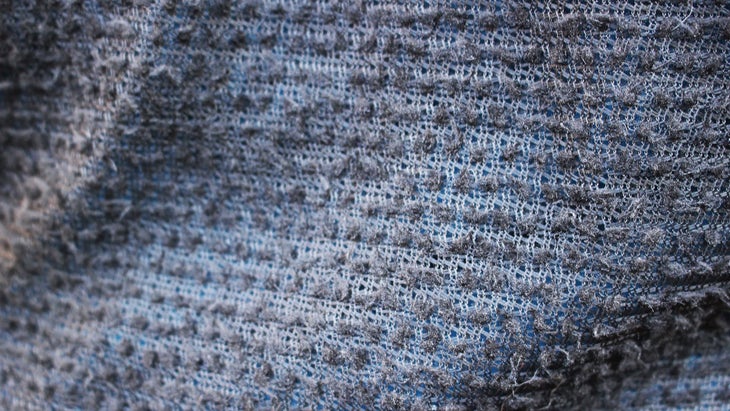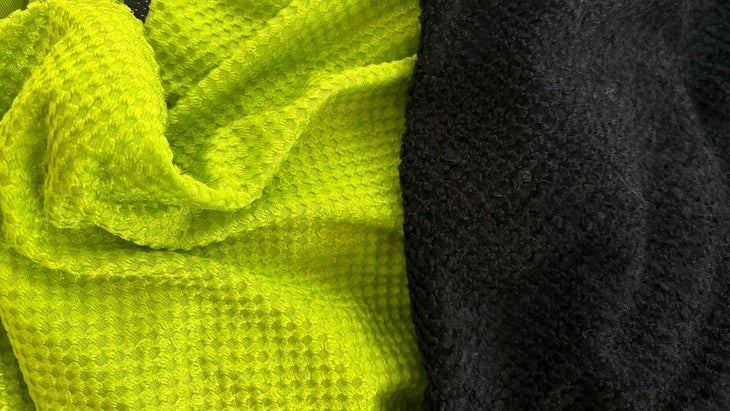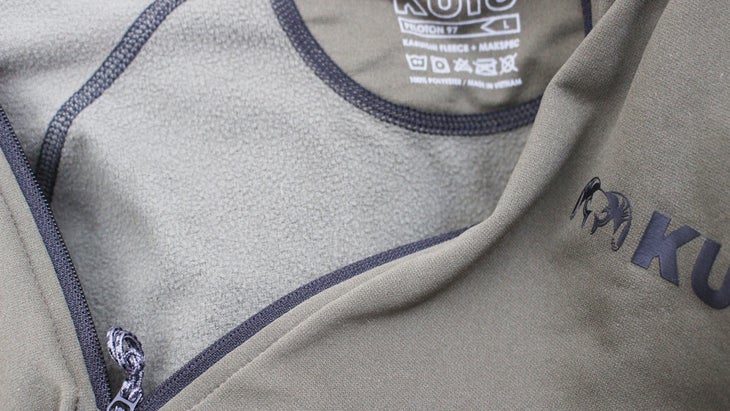Heading out the door? Read this article on the new Outside+ app available now on iOS devices for members! Download the app.
A fleece jacket or pullover has been the essential hiking layer for decades. Fleece is robust, keeps you warm even when you get wet, and is generally inexpensive compared to down and other synthetics.
But today’s options are vastly more technical and varied than your parents’ Patagonia pullover. Fleece hasn’t traditionally been the lightest choice of insulation, but that has changed over the years. The first big jump came with the introduction of “tech fleeces” like Polartec Powergrid in the 1990s that transformed the fleece from a warm jacket to a breathable “active insulation” layer that you could wear during exercise. The latest fleeces take that evolution a step further. The best ultralight options available now weigh as much as a T-shirt or sun hoodie—as little as 3 ounces—are more breathable than a merino baselayer, and still provide much-needed warmth when temperatures dip. Here, we compare the top choices on the market to help you pick your next featherweight fleece.

If you buy through our links, we may earn an affiliate commission. This supports our mission to get more people active and outside. Learn more.
Polartec Alpha Direct
Of all the next-gen fleeces, Alpha Direct has gotten the most buzz because of its impressive ability to shed heat and moisture. Worn alone, an Alpha Direct hoodie almost feels like nothing—you can feel air passing through it even at a slow walk. Since it hit shelves in 2017 (Polartec first developed it for the US military a few years earlier), Alpha Direct has become a nearly essential piece of kit among ultralighters and thru-hikers, equal in popularity to Altra trail runners and Zpacks shelters.
Its breathability is down to its unique construction. Alpha Direct is essentially a very loose weave of polyester threads with tufts of fleece interspersed throughout the fabric. (In lighter weights, Alpha Direct is basically see-through.) That means it’s one of the most breathable fleeces ever made for high-output activities, like chilly early morning hikes out of camp or spring ski touring; it’s almost impossible to feel overheated wearing this fabric, no matter how hard you’re pushing.
Perhaps the most unique characteristic of Alpha Direct is that it is essentially hydrophobic. That’s a double-edged sword. On one hand, you don’t get any of the sweat-wicking benefits that are common in many active insulation layers. On the other hand, if you do manage to break a sweat while wearing an Alpha hoody, it won’t readily get absorbed, preventing you from getting cold and clammy. The ideal combo? During strenuous activities, we wear an Alpha Direct hoodie over a base layer for its wicking characteristics, leaving us warm and dry.
As you might imagine, a fabric like this doesn’t perform much like other fleece layers. In windless conditions, or with a windshell layered over it, Alpha Direct provides outstanding warmth for its weight. But on its own, even a gentle breeze will overpower its ability to insulate. The lack of a face fabric also means that Alpha Direct has serious durability issues. Thorns, sharp branches, and even velcro will easily rip the fabric if you’re not playing close attention.
Alpha Direct is available in a variety of weights from 60 to 190, measured in grams per square meter (or GSM). To take advantage of the next-level breathability while still adding warmth and a bit of durability, we recommend Alpha Direct 90 or 120.
Bottom line: Best-in-class breathability and warmth, if you’re willing to deal with its fragility and pair it with a windbreaker.
As seen in:
Senchi A90 Half-Zip Hoodie ($95 at Senchi)
Rab Alpha Flash Jacket ($145 at Rab)
Sambob Alpha 90 Hoodie ($115 at Sambob)
Primaloft Active
Polartec and Primaloft are two giants of the insulation game. So when Polartec made waves with the release of Alpha Direct, it was just a matter of time until Primaloft’s alternative came along. In appearance, Active is nearly identical to Alpha Direct, with a loose weave, tufts of fleece everywhere, and all the same durability concerns. Like Alpha Direct, it’s also available in a variety of fabric weights. For ultralight layers, look for a weight around 120 GSM or below.
In terms of performance, Active is largely on par with Alpha Direct. It has next-level breathability thanks to that loose, fragile construction. As with Alpha Direct, pairing an Active layer with a windbreaker is the best way to make use of all of the lofty insulation it contains. Removing the windbreaker will allow you to dump heat incredibly quickly as things warm up.
The biggest performance difference comes down to water retention. Unlike Alpha Direct, Active will absorb a noticeable amount of sweat. It is still warm when wet and very quick-drying, but Alpha Direct is the only fabric on this list that seems to actually repel water.
One perk: Active is available in a 75 GSM version, which sits directly in between the Alpha Direct 60 and 90. Depending on your use case, the Active 75 might be the sweet spot for ultralight performance. Another potential upside is price. Eddie Bauer, a brand that often sells gear at hefty discounts, currently has the Seven Summits Active fleece on sale for $50. Alpha Direct is available from more brands (especially if you prefer to buy from a cottage outfit). But considering most cottage makers are routinely selling out, it’s unlikely you’ll find Alpha Direct on sale.
Bottom line: An alternative to Alpha Direct that could be cheaper, but isn’t quite as magically hydrophobic.
As seen in:
Eddie Bauer Super Sevens Fleece Hoodie ($99 at Eddie Bauer)

Teijin Octa
Like Alpha Direct, Octa is one of the lightest fleece fabrics available today. Its name derives from the eight-sided fiber used in its construction, which creates a hollow thread that saves weight and boosts air flow compared to standard synthetics. Like Alpha Direct, Octa is more breathable than other tech fleeces, and available in much lighter fabric weights. The lightest version of Octa that we’ve tested, found in the Zpacks Octa Hoody, is about 80 GSM.
There are several important differences between the Octa and Alpha. Octa looks much more like a standard tech fleece, with a woven face and a fleece backing. The tighter knit of the face fabric makes it more durable and less likely to snag and tear if you brush up against branches or thorns. It also boosts wind resistance, and we’ve found that Octa layers are more comfortable in cold conditions without needing to add a windshirt. (That said, wind resistance still isn’t great, and a windbreaker of some sort is highly recommended). On the flip side, breathability and moisture-retention aren’t quite on par with Alpha Direct. In general, we’ve found that we overheat faster and are noticeably sweatier in similar conditions while wearing Octa. The end result is a highly capable layer, but one that lacks the almost magical breathability of Alpha Direct.
Bottom line: Increased durability and versatility make Octa a no-fuss alternative to Alpha Direct, with a few performance drawbacks.
As seen in:
Zpacks Octa Hoody ($100 at Zpacks)
Mountain Hardwear Airmesh ($85 at Mountain Hardwear)
The North Face FutureFleece Half-Zip ($140 at TNF)

Toray Karuishi
Of all the ultralight fleeces on this list, the Toray Karuishi fleece is the most traditional. Like Octa, it has a face fabric with a fleece backing, but Karuishi’s weave is even tighter and less prone to damage. The fleece backing, meanwhile, is thinner but more continuous than Octa’s honeycomb pattern.
In all, Karuishi fleece is easily the most durable fabric on this list. It’s still a knit fleece, so it can certainly snag and pull on thorns. But unlike Alpha Direct, which has a weave loose enough that a ballpoint pen could pass through the fibers, Karuishi fleece isn’t noticeably fragile. We’ve worn a KUIU Peloton 97, which is made of Karuishi, while doing yardwork, on volunteer trail work days, and several bushwhacking adventures to little ill effect. Simply put, it doesn’t need to be babied.
During use, the differences between Karuishi and its loftier competitors are immediately apparent. Thanks to the denser face fabric, Karuishi fleece is more wind resistant—no windshell required in most cases. The downside? It’s less breathable and warm overall compared to Octa, and significantly less compared to Alpha. Finally, like Octa, it will absorb water and sweat, and once wet, dries slower than its competitors.
One other downside: while you can find Karuishi fleece in a few different jackets, KUIU is the only brand using the 97 GSM fabric, which is the only one to really consider for an ultralight layer. So if the KUIU Peloton 97’s quarter-zip design (available with or without a hood) isn’t what you’re after, you’re out of luck.
Bottom line: The top pick for anyone who prizes durability above other features.
